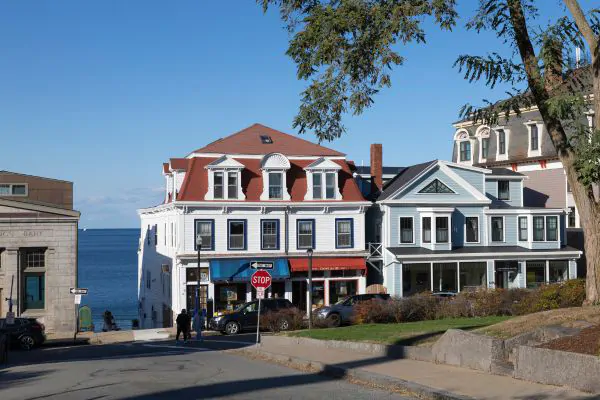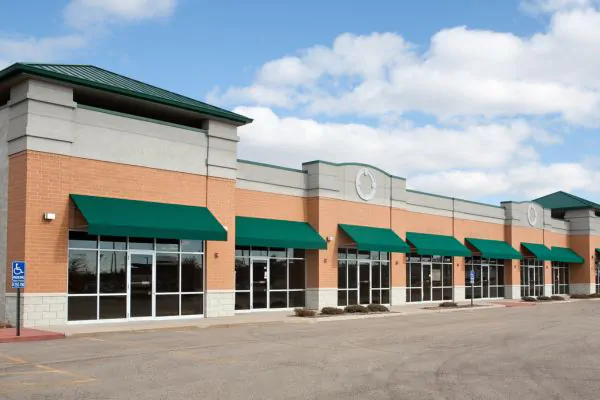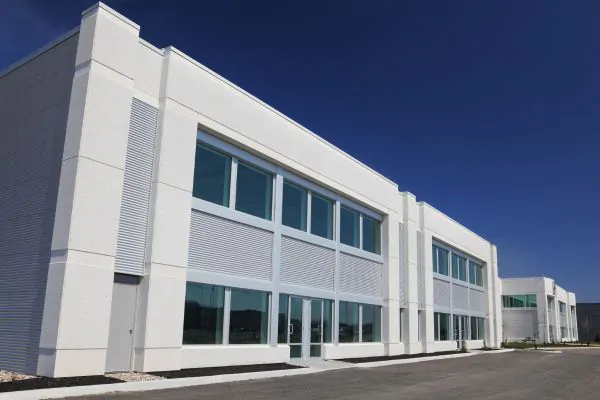I. Introduction
Selecting the right paint for a commercial building’s exterior transcends mere color choice; it is a pivotal decision that influences both the aesthetic allure and the durability of the property. The facade of a building not only encapsulates its identity but also serves as a shield against the elements, making the choice of paint a significant aspect of building maintenance and design.

This comprehensive guide aims to illuminate the path to choosing the perfect paint that complements the architecture, withstands the test of time, and aligns with the specific needs of a commercial establishment. Keep reading to unveil expert insights and tips that will aid in navigating the maze of commercial exterior paints.
II. Factors to Consider When Choosing Commercial Building Exterior Paint
Choosing the right paint for building exterior demands careful consideration of several crucial factors that go beyond surface aesthetics.
Durability and weather resistance stand paramount, ensuring the building can withstand the diverse challenges posed by the climate, from relentless sun exposure to torrential rains.
Maintenance and longevity are closely tied to this, as selecting a high-performance paint can significantly reduce the need for frequent touch-ups, translating into long-term cost savings.
Equally critical is the process of color selection, which must align with the brand’s image, enhancing visibility and recognition in a competitive landscape.
Lastly, cost-effectiveness weighs heavily in decision-making, requiring a balance between upfront expenses and the benefits of reduced maintenance and enhanced property value.
Together, these elements form a comprehensive framework for evaluating a commercial building exterior painting options, driving informed choices that contribute to the building’s structural and aesthetic integrity.

1. Durability and Weather Resistance
The resilience of paint against diverse weather conditions and its ability to retain integrity over time is a cornerstone for commercial property maintenance. Paints with enhanced durability and robust weather resistance are specifically formulated to combat the harsh impacts of UV rays, rain, and fluctuating temperatures, safeguarding the building’s exterior from fading, chipping, and damage. Investing in these high-quality paints not only elevates the building’s exterior aesthetics but also provides a protective barrier that prolongs the structure’s lifespan and minimizes future repair costs.
2. Maintenance and Longevity
The longevity of a commercial building’s exterior paint job is closely tied to the paint’s maintenance requirements. A high-quality paint not only ensures a façade that remains vibrant and intact for years but significantly reduces the frequency and extent of upkeep needed. By selecting paints designed for durability, building owners minimize the cycle of repainting, thereby economizing on both time and resources in the long run.
3. Color Selection and Brand Image
The selection of color and its alignment with a brand’s image is crucial in a commercial building’s exterior appearance, as it can significantly impact visibility and recognition among both clients and the larger community. Careful consideration of color palettes not only reinforces a company’s identity but also influences public perception, making it an essential element in the strategy for enhancing business presence and appeal.
4. Cost-Effectiveness
Cost-effectiveness in choosing exterior paint for a commercial property strikes a delicate balance between the initial expenditure and the long-term benefits of durability and maintenance savings. Selecting a paint that might have a higher upfront cost but offers superior resistance to elements and lower frequency of touch-ups can ultimately reduce overall expenses, making it a prudent investment in the building’s future condition and appearance.
Related Post: 5 Tips For Painting The Exterior Of A Commercial Building
III. Types of Commercial Building Exterior Paints
Selecting the perfect paint for a building’s exterior is not just about picking a color.
The type of paint you choose can significantly influence commercial property’s appearance, durability against the elements, and even maintenance costs over time.

With options ranging from acrylic to oil-based, and water-based latex paints, each offers unique benefits suited to different surfaces and climates.
Additionally, specialized coatings provide tailored solutions for challenges such as graffiti, heavy wear, and extreme weather conditions.
Understanding the properties and applications of these various paint types is essential for making an informed decision that ensures both aesthetic appeal and long-lasting protection for your commercial property.
A. Acrylic Paints
Acrylic paints stand out for their versatility and robustness, making them an excellent choice for commercial building exteriors. Their inherent durability against weather, UV rays, and moisture, coupled with their vibrant color retention, ensures that buildings not only maintain their aesthetic appeal but also benefit from an added layer of protection. Tailored for a range of surfaces, including masonry, wood, and metal, acrylic paints offer commercial property owners a resilient and appealing finish.
B. Oil-Based Paints
Oil-based paints, recognized for their resilience and sleek finish, are a formidable choice for commercial property exteriors facing harsh environmental elements. Their superior adhesion properties and resistance to staining and wear make them ideal for surfaces that demand a durable and protective coating. While they necessitate more meticulous application and longer drying times, the investment in oil-based paints pays dividends through their enduring beauty and shield-like barrier against damage.
C. Water-Based (Latex) Paints
Water-based (latex) paints emerge as a favored option for commercial building exteriors due to their environmental friendliness and ease of application. This type of paint dries quickly and emits lower levels of volatile organic compounds (VOCs), making it a safer choice for both the environment and the applicators. Its elasticity also stands up exceptionally well to fluctuations in temperature, reducing the likelihood of cracking and thus extending the paint’s lifespan on a building’s facade.
D. Specialized Coatings (Elastomeric, Anti-Graffiti, etc.)
Specialized coatings such as elastomeric and anti-graffiti paints protect commercial building exteriors from specific challenges. Elastomeric coatings offer exceptional stretchability, bridging minor cracks and imperfections in surfaces, effectively waterproofing and protecting the façade from moisture infiltration. On the other hand, anti-graffiti paints provide a surface that allows for the easy removal of graffiti, maintaining a building’s aesthetic integrity and reducing the need for costly and time-consuming cleanups.
You might like: Benefits Of Painting Your Commercial Building
IV. Application and Preparation Tips
Transitioning from the foundational knowledge of selecting paint to the practical aspects of application underscores the vital preparatory steps and considerations necessary for achieving the best results on a commercial building’s exterior.
This section delves into the essentials of surface preparation — a critical phase that ensures paint adheres properly and lasts longer.
Additionally, it explores the decision between hiring professional painters and the feasibility of DIY paint jobs.
Both routes have unique advantages and challenges, requiring careful deliberation to align with the project’s scope, budget, and desired outcomes.
A. Surface Preparation
Proper surface preparation is the linchpin for ensuring the longevity and adherence of paint to a commercial building’s exterior. This critical step involves thoroughly cleaning the surface, which may include pressure washing to remove dirt, grime, and old paint, followed by the repair of any cracks, holes, or uneven areas to create a smooth substrate. Neglecting this phase can lead to premature paint failure, undermining the investment in quality materials and skilled application.
B. Hiring Professional Painters vs. DIY
Deciding between employing a commercial painting company and attempting a DIY project involves weighing the complexities of the task against the skills and resources at one’s disposal. Painting contractors bring a wealth of experience, efficiency, and access to high-quality tools that ensure a durable and aesthetically pleasing finish, often backed by warranties and liability insurance. Conversely, a DIY approach might offer cost savings for those with the necessary expertise, but risks include the potential for subpar workmanship, and the absence of professional commercial painting services recourse should issues arise.
V. Compliance with Local Regulations
Ensuring compliance with local regulations is a pivotal aspect of commercial building exterior painting. Navigating the maze of building codes and ordinances demands diligent research and adherence to specific standards set forth by local authorities.
Ignoring this step can lead to operational delays, financial penalties, and even legal issues, undermining the entire paint selection and application process. As such, understanding and conforming to these regulations not only ensures legal compliance but also guarantees that the chosen paint contributes positively to the community’s aesthetic and environmental standards.
A. Researching and Adhering to Local Building Codes
Researching and adhering to local building codes is an essential step for property owners wishing to do their commercial building exterior painting. Compliance ensures that all remodeling and renovation efforts, including painting, meet specific safety, environmental, and aesthetic standards deemed necessary by local authorities. By thoroughly understanding and following these regulations, building owners safeguard their projects against legal complications and contribute to the community’s well-being.
Conclusion
In conclusion, choosing the right paint for your commercial building exterior is a multifaceted decision that significantly impacts both the aesthetic appeal and structural integrity of the property.
Durability, weather resistance, maintenance requirements, color selection, and cost-effectiveness play pivotal roles in ensuring the façade withstands environmental challenges while reinforcing the brand’s image.
Exploring various types of paints, such as acrylic, oil-based, latex, and specialized coatings, offers tailored solutions to meet these demands. Proper surface preparation and the choice between hiring painting contractors or a DIY approach are critical for achieving lasting results.
Additionally, compliance with local regulations guarantees that the painting project aligns with community standards and avoids legal complications.
Ultimately, an informed paint choice not only enhances the building’s appearance but also contributes to its long-term preservation and value.
Consult Commercial Painting Company for a Branded Building Exterior
When it comes to making a lasting impression, the exterior of your building plays a crucial role. A drab and worn-out exterior can give off the wrong message to potential clients and customers. This is where South Shore Painting Contractors, a reputable commercial painting company, comes into the picture. With our expertise in exterior commercial painting, we can transform your building’s exterior into a work of art that represents your brand and leaves a lasting impact on anyone who lays eyes on it. Contact us today!





